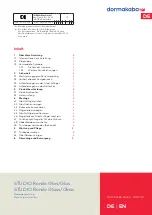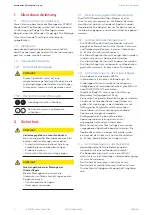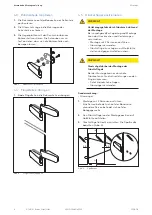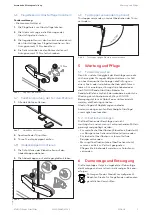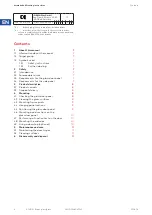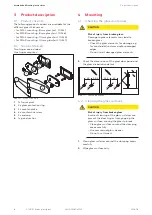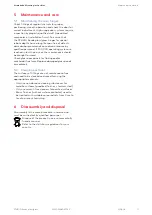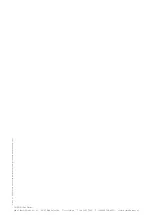
1
About this manual
1.1 Information about the manual
This manual describes the installation of STUDIO
Rondo glass/glass hinges and contains information on
care and maintenance. The mounting is shown using
the example of a left-opening door. The mounting for
a right-opening door is laterally inversed.
1.2 Target group
dormakaba glass fittings may only be installed by
qualified personnel who are specially trained in
glazing installation.
1.3 Symbols used
1.3.1 Safety instructions
CAUTION
This signal word indicates a situation of
potential risk, which could lead to minor or
slight injury if not averted.
1.3.2 Further labeling
2.
1.
Step-by-step graphics
1
2
Position numbers for parts
in graphics
2 Safety
CAUTION
Risk of injury from sharp edges.
Incorrect handling during mounting can
cause the glass to break, resulting in injury.
• Read and follow the safety instructions in
this manual carefully.
• Make the installation site safe.
• Wear personal protective clothing.
CAUTION
Risk of crushing during installation of the
glass door panel.
During mounting, there is a risk of crushing
injuries to the fingers by the glass edges.
• Wear protective gloves.
• Use glass suction cups.
2.1 Intended use
STUDIO Rondo glass/glass hinges are designed for
interior Glass Doors. The hinges clamp the glass door
panel between the panel section and the counter-
plate. The hinges are only designed for dry interior
applications and pivots must be vertically aligned.
2.2 Foreseeable misuse
• STUDIO Rondo glass/glass hinges are not suitable
for showers, sauna, bath or salt-water bath
applications or areas where chemicals (e.g. chlorine)
are used.
• Glass door panels must not be swung open, they
need to be opened by hand.
• Glass door panels must not be slammed shut.
• A device, such as a doorstop, must be installed to
prevent the glass door panels from opening too far.
2.3 Requirements for the glass door panel
• Toughened safety glass (TSG)
• In areas with additional requirements, e.g.
nurseries, the use of heat-soaked toughened safety
glass (TSG-H compliant with DIN EN 12150-1) is
recommended.
• Glass thickness 8 or 10 mm, depending on version.
• Maximum door panel weight 35 kg
• Do not use self-cleaning coatings.
• Textured glass surfaces or glass of heavily varying
thickness should only be used with a corresponding
leveling layer.
• Do not use glass with conchoidal fractures and/or
damaged edges.
• Installation should be free of tension (torque should
not be exceeded by over-tightening screws).
• The specified gaps must be taken into account
when aligning the glass door panel. The gaps must
be such that the glass is prevented from coming
into contact with hard materials (e. g. glass, metal,
concrete).
2.4 Requirements for the side panel
• dormakaba recommends fixing the side panel with
a wall connecting profile.
• A U-profile must be used for fixing to the floor; a
silicone joint is not sufficient for this purpose.
• The side panel must be level and vertically aligned.
• The side panel and supporting structure must be
capable of bearing the weight of the glass door
panel.
7
STUDIO Rondo glass/glass
2018-09
WN 059480 45532
dormakaba Mounting instructions
About this manual

